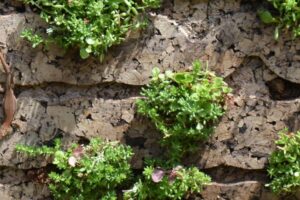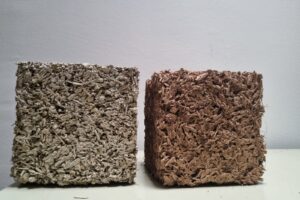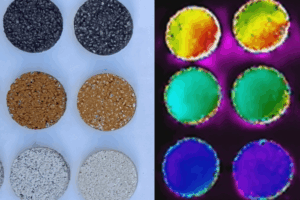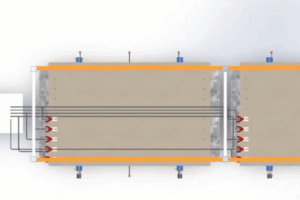
INSESS-COVID19: Artificial intelligence to detect and attend to people in situations of vulnerability
December 1, 2022
MultiDEPART: A project to facilitate the deployment of transport services on demand
December 16, 202213/12/2022
The use of fibre-reinforced concrete (FRC) is a significant advance for the construction industry, in the industrial sector and in underground or prefabricated construction. In most fibre-reinforced structures, steel fibres are used (steel-fibre reinforced concrete, SFRC). However, over the last ten years, the use of synthetic microfibres has been gradually introduced in structural applications. This use has clear advantages over steel-based reinforcements for concrete in marine environments, as synthetic fibres do not corrode due to the salts dissolved in seawater or transported by the wind. In this way, the costs of repair and maintenance can be reduced, and the level of sustainability of the structures increased.
- © Fernando Alda
Pavilions of Puerto de Motril (Granada) made from prefabricated concrete panels reinforced with synthetic microfibres. Design: Elisa Valero (PhD Architecture, Prof. Univ. of Granada) and structural calculations: Albert de la Fuente (PhD Civil Engineering, Prof. UPC and coordinator of the CREEF project).
Despite this, the use of synthetic macrofibres to reinforce steel structures is not considered sufficiently in international design guides. Consequently, their use is limited to non-structural elements or elements with little structural importance (for example, flooring and sprayed concrete for non-resistant tunnel coatings). At regulatory level, the use of synthetic-fibre reinforced concrete in elements of greater structural importance is hampered by lack of knowledge. This is due to a lack of research into the response of the material when it is subjected to fatigue and creep in cracked elements (elements of reinforced steel subjected to flexion are designed to crack or at least the potential of cracking should be considered).
Expected results
In this context, CREEF has been developed: a project whose aim is to provide representative results in these situations via experimental programmes (image on the right) and numerical approaches to be able to include synthetic macrofibres as reinforcement for concrete structures in design guides.
Rack with pre-fissured concrete reinforced with microfibres and loaded for 9 months to quantify the potential effects of creep. A beam tested until failure after 9 months of a permanent load. Tests carried out in the UPC Structures and Materials Technology Laboratory (LATEM) “Lluís Agulló”, as part of the CREEF project.
Contribution of the UPC
CREEF is carried out with the collaboration of two research groups: the Construction Engineering Group (EC) and the Architecture and Technology Group (GAT), both with experience in materials and tests in structures, as well as numerical parametric simulation.
Fundamental aspects will be covered, such as the connections between prefabricated elements of concrete and their seismic response. For this reason, prototypes of prefabricated concrete for marine environments will be designed and tested. Notably, in maritime zones and their surrounding areas, metal-based reinforcing bars for concrete are prone to suffer from problems of corrosion and require an economic investment during their useful life. The new solutions that are proposed will represent alternatives with higher sustainability indices (measured using the approaches developed in the project) and greater competitiveness than existing solutions. The results of this project will represent considerable advances with respect to knowledge of fibre-reinforced concrete and their structural use, which are required to ensure the inclusion of this material in future reviews of standards.
Budget and financing
Other participants in the project are the companies MBCC Group and Smart Engineering (a UPC spin-off). The total budget for the project is €151,250. It was funded by the State Plan for Scientific and Technological Research and Innovation 2017-2020. CREEF started at the beginning of June 2020 and will end at the end of May 2023.
Related Projects
SATE-VEG: A system for energy renovation of buildings that helps reduce the urban heat island effect
Researchers from the Architecture, Energy and Environment (AiEM) group at the Universitat Politècnica de Catalunya - BarcelonaTech (UPC) have developed SATE-VEG, an external thermal insulation system with a vegetal coating that offers seasonally adaptive thermal behaviour, enhances urban biodiversity and promotes positive health effects. The system is made from organic materials, requires low maintenance and consumes minimal water.- A research team from the Interdisciplinary Group on Building Science and Technology (GICITED) at the Universitat Politècnica de Catalunya – BarcelonaTech (UPC) is leading the BioSAFE project, which aims to develop sustainable building envelopes —mainly façades— designed according to sustainability, comfort and safety criteria, with particular attention to their acoustic behaviour and fire performance.
- The Construction Materials and Roads (MATCAR) research group at the Universitat Politècnica de Catalunya - BarcelonaTech (UPC) has carried out the RELUM project with the aim of researching and developing innovative solutions to help prevent global warming, through the design of sustainable pavements with reflective and photoluminescent properties, in collaboration with the company Sorigué.
- The Structural and Materials Technology (ATEM) research group at the Universitat Politècnica de Catalunya - BarcelonaTech (UPC) is participating, in collaboration with the Universitat de les Illes Balears (UIB), in the ReINfoRCed project, which aims to promote the extension of the service life of reinforced concrete structures affected by corrosion.








